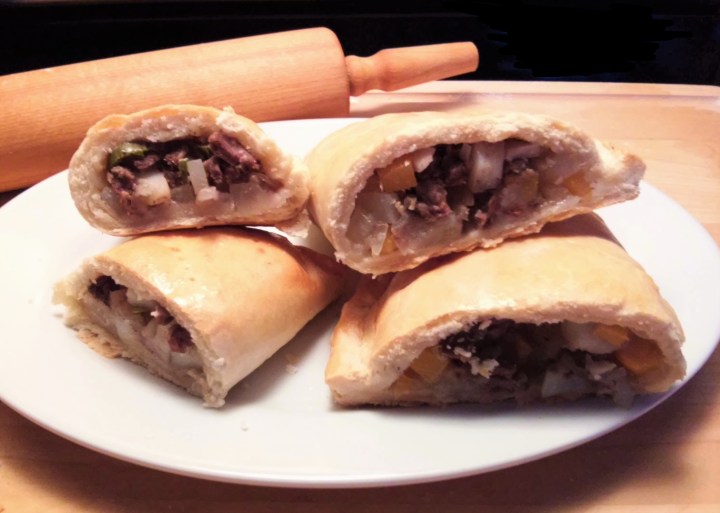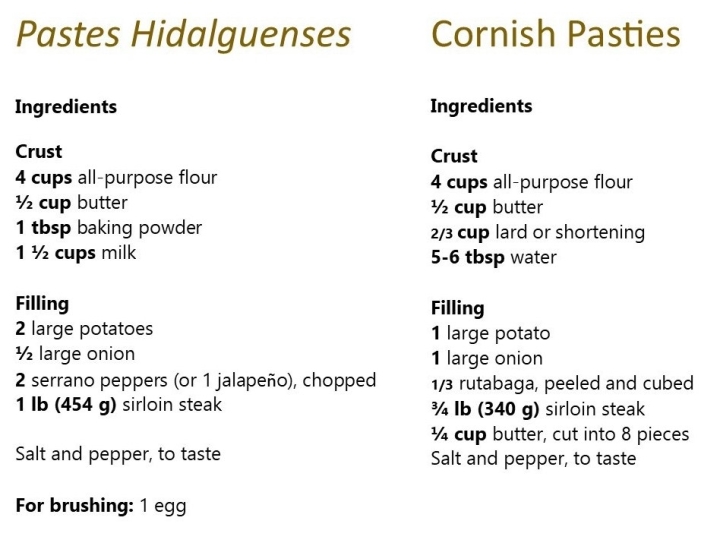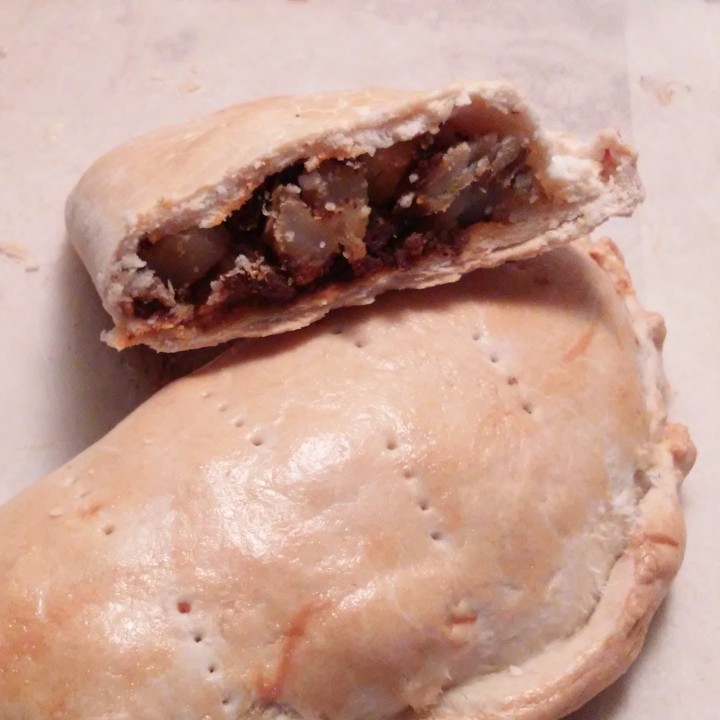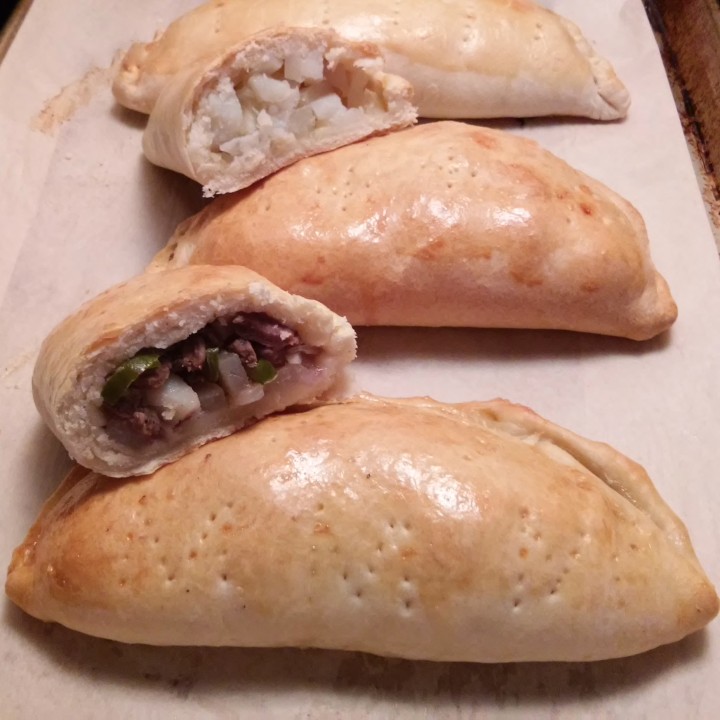
It was so much fun planning and cooking fusion recipes inspired by Mexico’s participation in the FIFA World Cup in Russia, that I ended up trying to find connexions between Mexican food and the four finalist countries. Curiously, they are all European (England and Belgium playing for third place on Saturday, July 14, and France and Croatia for the top spot on Sunday, July 15). I found many interesting stories so I am certain I will revisit the topic, but there was one that stood out because it already involved soccer and food. When Mexico became an independent country in 1821, a lot of its infrastructure was in deplorable conditions. Out of fear of an economic impact too great to overcome alone, the new Mexican government allowed foreign companies to make repairs and exploit natural resources in the country. The silver mining sites in Real del Monte and near Pachuca, in the state of Hidalgo, were bought by English investors, who recruited a large number of miners and engineers from Cornwall, in the Southern end of the British Isles. With their modern technology, they drained, cleaned and updated the silver mines. By the 1840s, there were hundreds of English nationals in the area, and many decided to stay. They became an important sector of the community: a Methodist church was built at the turn of the 20th century; there is an English cemetery; and today, some English last names are still common in Pachuca and Real del Monte. On their free time, amongst other things, they played football (soccer), which was promptly adopted by the locals; in fact, Mexico’s first organized “fútbol” team was Club Pachuca, and the city hosted Mexico’s first international match in 1902. They also brought ingredients for their food, unknown in Mexico at the time, such as nabos suecos (Swedish turnips, also known as swede or rutabaga) for their Cornish pasty (pronounced to rhyme with “nasty”). This baked dough pocket filled with meat and vegetables was very popular amongst the miners, for its portability and calorie content. Pasties became so ingrained in Real del Monte’s traditions, that they got their own name in Spanish – pastes (sounds like “past” and the letter “s”). There is also an annual pastes fair, and in 2009, the Museo del Paste (the Pasties Museum) opened its doors, where visitors learn about the history of the pasties in Hidalgo, and they get to bake their own. Real del Monte even hosted the Duchess of Cornwall and Prince Charles in 2014! There is a beautiful article, with great photos and details about this town and the history of pastes; I particularly liked it because it refers to Real del Monte as “Mexico’s little slice of Cornwall.”
I checked several recipes, and decided to make a batch of each the Cornish and hidalguenses patties, instead of trying to create a third version. For the Cornish pasties, I combined a recipe a lady at my church kindly shared for our parish recipe book (she is originally from Wales; thank you, Sue!) and the BBC’s “Perfect Pasties”. For the pastes, I found that the main difference is in the pastry, lighter and probably a little less expensive than the original. The filling remained the same, although some recipes omit the rutabaga; also, most call for hot peppers, which add a Mexican touch. I am posting my compilation of the recipes in parallel, as a comparison of ingredients and methods.
Printable recipe – Pastes Hidalguenses and Cornish Pasties
 I peeled and cubed the potatoes and onions, and mixed with the other vegetables in bowls. Then, I chopped the steak into very small pieces, setting aside as well. To make the dough, I rubbed the fat into the flour to obtain a sandy texture. Adding the rest of the ingredients produced firm dough. The Mexican dough formed a larger, more airy, ball (left) and the Cornish dough was a little harder to knead, and more compact (right):
I peeled and cubed the potatoes and onions, and mixed with the other vegetables in bowls. Then, I chopped the steak into very small pieces, setting aside as well. To make the dough, I rubbed the fat into the flour to obtain a sandy texture. Adding the rest of the ingredients produced firm dough. The Mexican dough formed a larger, more airy, ball (left) and the Cornish dough was a little harder to knead, and more compact (right):

Pasties are quite a large patty, as they were the miners’ full meal, so the recipes instruct to divide the dough into four pieces. Each piece was formed into a ball, then flattened into a circle with a rolling pin, to about 8 inches in diameter. Each circle was topped on one half with a fraction of the vegetables and meat, forming a mound; I then placed two pieces of butter on the mound. A sprinkle of salt and pepper was the last step for the filling. The egg was beaten in a small bowl, and used to brush all around the edge of the round, folding the empty half of dough over, to form a half-moon shape. I crimpled the edge with my fingers, making sure that it was well sealed. I placed the pasties on a cookie sheet lined with parchment paper. I pricked the top of the pasties with a fork, to allow steam to be released during cooking. I repeated with each piece of dough:

I finished the Cornish pasties first, brushing the top with egg (the pasty with dotted crosses is vegetarian, with no steak):

These were baked in the oven, preheated to 400°F (204°C) for 10 minutes, then at a reduced temperature of 350°F (180°C) for approximately 45 minutes. Meanwhile, I repeated the assembly operation for the pastes hidalguenses. They are smaller than the Cornish pasties, probably reduced in size overtime, as they did not need to feed a hungry miner for a whole day, and becoming a treat for everyone to enjoy. The recipes I checked said the dough would be enough for five to six patties, so I divided it into sixths. I followed the same procedure to assemble, except the circles measured six inches in diameter, and there was no addition of butter to the filling. Once the Cornish pasties were golden brown and removed from the oven, I raised the temperature back to 400°F (204°C), baked the pastes for 10 minutes, and continued baking at 350°F (180°C) for approximately 35 minutes.
The photo at the top of the post shows a paste hidalguense (left) next to a Cornish pasty; the differences in size, crumb texture and filling may be appreciated. Below, a golden brown Cornish pasty (top) sits next to a similarly crispy paste hidalguense:

For those who are not intimidated by petulant purists, pastes and pasties may be filled with other savoury or sweet fillings, such as: chicken, chorizo, mole, tuna (from canned), fruit (such as pumpkin, of Harry Potter fame), rice pudding, etc. I made a couple of vegetarian patties filled with vegan chorizo and potato:

And also a couple without the steak; as I mentioned above, I marked the “no-steak” veggie patties with dotted crosses; for the pastes, I also thought of marking the ones with meat with a row of the letter M:

I thought I was being clever, but apparently, it was a practice that any Cornish wife would use to mark her husband’s pasty with his initials, so that if he saved some for later, he could distinguish it from his colleagues’. There was also a superstition about some mischievous little people, called the “Knockers”, who lived in the mines and were believed to cause misfortunes, unless they were bribed with small amounts of food. The initials carved into the pasties made sure that those miners who left their crusts for the Knockers could be identified and hence, spared from the bad fortune.
My family and I tried both kinds last night, which were liked pretty well and mostly equally, so there was no clear winner. As I am finishing this post, I am snacking on a piece of leftover, placed in the fridge last night, then left out a couple of hours ago to reach room temperature, and it is very tasty. Warming up in the microwave or toaster oven also worked fine. Calorie wise, the paste is the skinny choice, being smaller and containing no lard and less butter.
FUN FACT: Similar stories of the Cornish miners’ expertise in other parts of the world have resulted in different iterations of the Cornish pasties, for example, in Australia, where more vegetables were added, or Upper Michigan, in the US, where pasties are often called Yoopers, and served with ketchup.
I am sharing my post at Thursday Favourite Things #500, with Bev @ Eclectic Red Barn, Pam @ An Artful Mom, Katherine @ Katherine’s Corner, Amber @ Follow the Yellow Brick Home, Theresa @ Shoestring Elegance and Linda @ Crafts a la Mode.
I am bringing my recipe to Full Plate Thursday #547 with Miz Helen @ Miz Helen’s Country Cottage.








Both versions look so tasty! Love such pastries. 🙂
LikeLike
Thank you!
LikeLiked by 1 person
Very nice!
LikeLike
Thank you!
LikeLike
oh wow, I love Cornish Pasties. There is a restaurant in Tempe that does them. I’ll definitely have to give it a try.
LikeLiked by 1 person
Let me know how they turn out!
LikeLiked by 1 person
Thanks so much for sharing your awesome post with us at Full Plate Thursday,547. Hope you are having a great summer and come back to see us soon!
Miz Helen
LikeLike
Thank you Miz Helen, and thank you for hosting!
LikeLike
Irene,
Wow, these sound so good. Congratulations, you are being featured on Thursday Favorite Things. I hope you stop by. https://www.eclecticredbarn.com/2021/08/thursday-favorite-things-party.html
Hugs,
Bev
LikeLike
Thank you so much, Bev, and thank you for hosting, see you there!
LikeLike